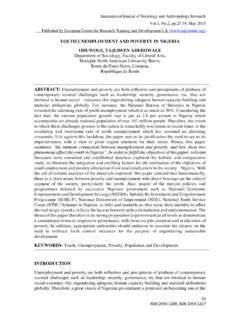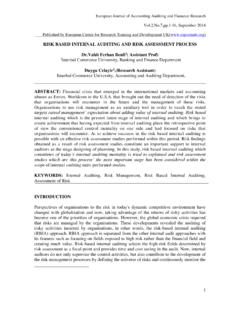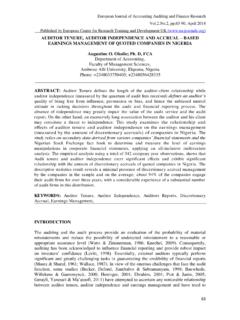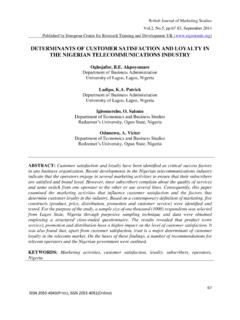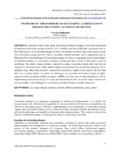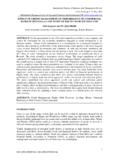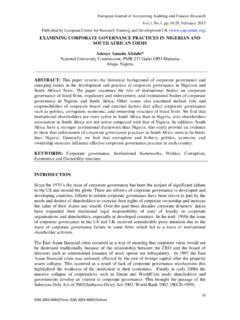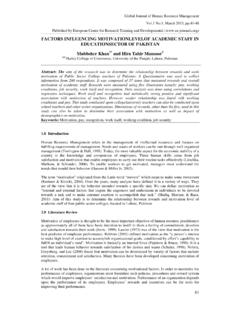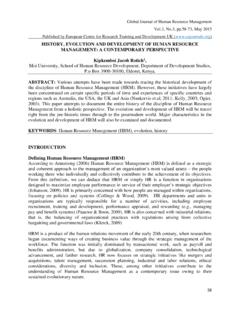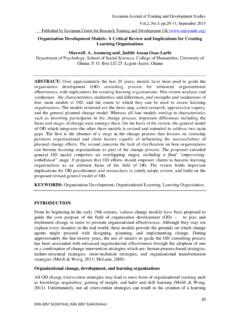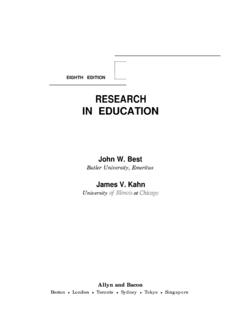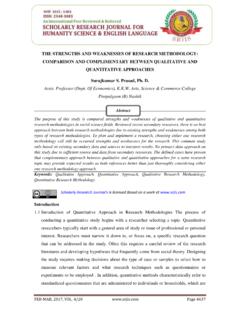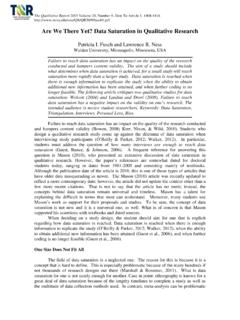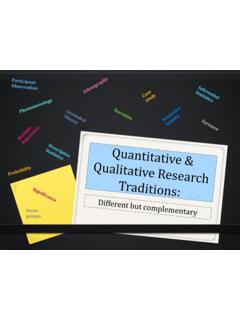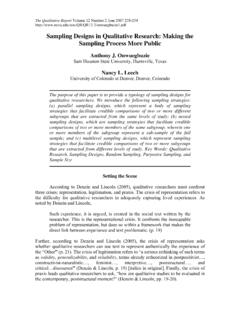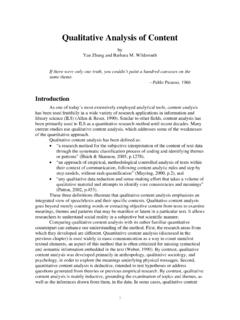Transcription of STATISTICAL ANALYSIS: INTERNAL-CONSISTENCY ... - EA …
1 International Journal of Quantitative and Qualitative research Methods , , , February 2018 ___Published by European Centre for research Training and Development UK ( ) 27 ISSN 2056-3620(Print), ISSN 2056-3639(Online) STATISTICAL ANALYSIS: INTERNAL-CONSISTENCY RELIABILITY AND CONSTRUCT validity Said Taan EL Hajjar Ahlia University ABSTRACT: In testing a proposed model of any academic field, huge extents of data are collected and analyzed through a proposed or adopted scale by researchers. It is very significant to test the reliability and the construct validity of this scale. This study aims to explore the important strategies or tools that should be followed to achieve a reliable and valid scale. It also aims to study the two concepts in association with scale testing as well as to afford a snapshot of the recent understandings of the reliability and validity of scale tests as expressed in previous research studies.
2 This paper emphasis mainly on the theoretical and practical parts of reliability, and the affiliation between the two perceptions. Seeking to synthesize research results about the construct validity and INTERNAL-CONSISTENCY reliability of items (factors), we focus on the four main measurements: Cronbach s alpha, inter- item correlation, corrected item total correlation, and Cronbach s alpha if item deleted. These measurements would provide researchers with a clear knowledge about purifying the survey s scale before using it in collecting the data set. This kind of research is required so that a complete understanding of the construct validity and internal consistency reliability of items is realized. KEYWORDS: Scale, Cronbach s Alpha, INTERNAL-CONSISTENCY , Reliability, Construct, validity INTRODUCTION In most of the academic research studies, especially in the field of business, researchers employ a survey study to test a developed model or testing hypotheses to support the theory it has to be measured.
3 For the STATISTICAL expert functioning with researchers the estimation of reliability and validity is a mission often encountered. The measurement of aspects differ particularly in the field of business as they are associated with the quantification of abstract and invisible factors. Then in several cases the meaning of quantities is only incidental. Most perceptions in the behavioral businesses have significance within the setting of the theory that they belong to. Each perception, then, has a functioning definition which is ruled by the principal theory. If a perception is elaborated in the hypothesis testing to satisfy the theory it should be measured. So the primary decision that the study is tackled with is how the perception shall be measured ( the type of measure).
4 In fact, there are many types of measurement. It can be observational, interview, self-report, etc. These types eventually get customized with a precise form such as observing an event on a video-tape, observing a continuous activity, self-report measures ( surveys that can be open-ended or close-ended), Likert-type scales etc. There is no doubt that each type of measure possesses definite types of concerns that require to be exposed in order to make the measurement significant, precise, and efficient. International Journal of Quantitative and Qualitative research Methods , , , February 2018 ___Published by European Centre for research Training and Development UK ( ) 28 ISSN 2056-3620(Print), ISSN 2056-3639(Online) One more important aspect is the population along which it is intended to be measured.
5 This choice is not completely reliant on the theoretical pattern but further to the availability of the instant research question. Another important issue is the aim of the scale or measure. That means, What is it that the researcher wants to do with the measure? Is it settled for a precise study or is it settled with the expectation of general procedure with similar populations? At the time these perceptions are satisfied and a measure is established, which is a sensitive process, then the following questions are to be raised how can be sure that we are certainly measuring what we need to measure? since the concept that we are measuring is intangible, and can we be certain that if we retest again the measurement we will have similar results?
6 The first question is associated to validity , while the second one is related to reliability. Young researchers frequently ask the following question: Can we adopt a questionnaire developed by a certain scientist to be used in collecting our data? In fact, there is more than one response. Firstly, if this adopted questionnaire satisfies the researcher s research needs, then it is possible to be applied in his/her research study. Secondly, the researcher can omit or add some factors related to this adopted survey before collecting the data. However, in both cases it is extremely recommended to test the reliability and validity of this survey. The reason is many features may affect the validity and the reliability of these adopted questionnaires such as culture, population, sample size, etc.
7 In addition, we should keep in mind that the old scientist purified his questionnaire through a sample selected from a certain population. Some researchers start to develop their questionnaire from zero. That is they create the factors of their latent variables. In this case, a factor analysis test is needed in which reliability and validity are parts of it. Therefore, for a non- statistician researchers, it is preferable that they adopt a previous reliable - valid scale, make little modification on its constructs to fit their topic, and, then, test the reliability and validity of this new modified scale. The measurements of performances and constructs are issued to error that may influence the measurements of reliability and validity .
8 In fact, a measuring instrument that is reliable provides the same measurements when a researcher frequently measure the similar unchanged items or events. The detected value on an instrument can be measured by: Detected value = true value + error (1) Knowing that an instrument is considered reliable if it precisely reflects the true value, and then minimizes the residual (error) factor. The reliability coefficient is computed by the following formula: Reliability Coefficient = (True variability) / (Total detected variability) (2) That is, if the value of a reliability coefficient is equal to , this indicates that 75% of the variability in detected values is assumed to describe true individual differences and 25% of the variability is due to random residual.
9 International Journal of Quantitative and Qualitative research Methods , , , February 2018 ___Published by European Centre for research Training and Development UK ( ) 29 ISSN 2056-3620(Print), ISSN 2056-3639(Online) In this paper, there will be brief literature review about the reliability and validity concepts, and a procedure used to express reliability and validity tests. LITERATURE REVIEW In order for a survey to be valuable and of use, it must be both reliable and valid. If a scale is valid, then it must be reliable. For instance, students have different marks on a given exam every time they take it, the exam is not probably to foretell anything. However, when an exam is reliable, that does not imply that it is necessary valid. For instance, we may measure strength of grip very reliably, but that does not make it a valid measure of intelligence.
10 So reliability is a necessary, but not sufficient, condition for validity . validity analysis requires to emphasize on the aim and use of the results achieved by a certain test, and needs further than a quantitative analysis of the obtained results. Specifying the significance of reliability and validity measurements on the part of instructors, Weigle (2007) states Teachers should not hesitate to ask questions about the reliability and validity of the tests that their students are required to take and how test results will be used, and teachers should be proactive in bringing issues of questionable testing practices to the attention of administrators. The progression of test validation requires gathering information about the reliability and validity of a test in terms of its satisfaction of the aim it is intended for, and scores consistency on the basis of evidence resulted from the scores.
